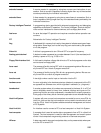
Glossary
550
Programmable Controller A computerized device that can accept inputs from external devices and gener-
ate outputs to external devices according to a program held in memory. Pro-
grammable Controllers are used to automate control of external devices. Al-
though single-component Programmable Controllers are available, building-
block Programmable Controllers are constructed from separate components.
Such building-block Programmable Controllers are formed only when enough of
these separate components are assembled to form a functional assembly, i.e.,
no one individual Unit is called a PC.
programmed alarm An alarm given as a result of execution of an instruction designed to generate the
alarm in the program, as opposed to one generated by the system.
programmed error An error arising as a result of the execution of an instruction designed to gener-
ate the error in the program, as opposed to one generated by the system.
programmed message A message generated as a result of execution of an instruction designed to gen-
erate the message in the program, as opposed to one generated by the system.
Programming Console The simplest form or programming device available for a PC. Programming
Consoles are available both as hand-held models and as CPU Unit-mounting
models.
Programming Device A peripheral device used to input a program into a PC or to alter or monitor a
program already held in the PC. There are dedicated programming devices,
such as Programming Consoles, and there are non-dedicated devices, such as
a host computer.
PROGRAM mode A mode of operation that allows inputting and debugging of programs to be car-
ried out, but that does not permit normal execution of the program.
PROM Writer A peripheral device used to write programs and other data into a ROM for per-
manent storage and application.
prompt A message or symbol that appears on a display to request input from the opera-
tor.
PV Acronym for present value.
Rack An assembly of various Units on a Backplane that forms a functional unit in a
building-block PC System. Racks include CPU Racks, Expansion I/O Racks, I/O
Racks, and Slave Racks.
refresh The process of updating output status sent to external devices so that it agrees
with the status of output bits held in memory and of updating input bits in memory
so that they agree with the status of inputs from external devices.
relay-based control The forerunner of PCs. In relay-based control, groups of relays are intercon-
nected to form control circuits. In a PC, these are replaced by programmable cir-
cuits.
Remote I/O Master Unit The Unit in a Remote I/O System through which signals are sent to all other Re-
mote I/O Units. The Remote I/O Master Unit is mounted either to a CPU Rack or
an Expansion I/O Rack connected to the CPU Rack. Remote I/O Master Unit is
generally abbreviated to Master.
Remote I/O Slave Unit A Unit mounted to a Backplane to form a Slave Rack. Remote I/O Slave Unit is
generally abbreviated to Slave.


















